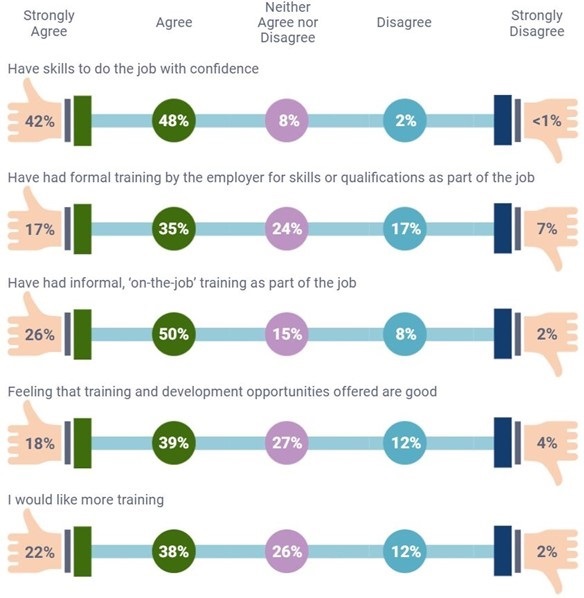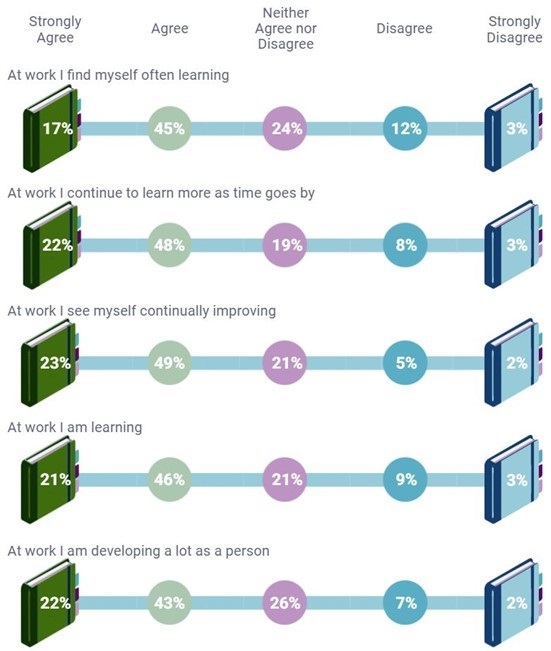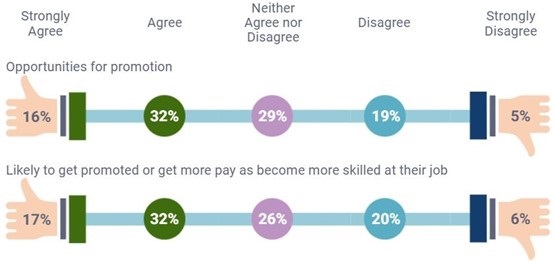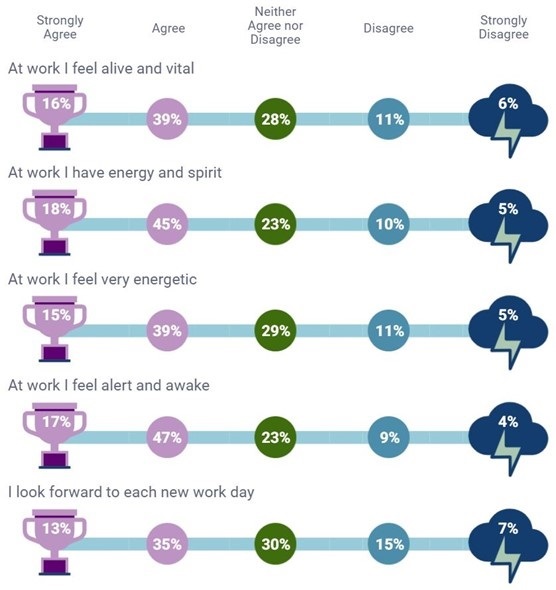Developing and thriving at work
This section explores developing and thriving at work. Firstly, confidence, skills, and perceptions of training and development opportunities are examined. Then, thriving at work is also explored, comprising vitality and learning dimensions.
On this page
Thriving is a psychological state composed of the joint experience of vitality and learning. Porath et al. (2012) define thriving as “people who are thriving experience growth and momentum marked by both a sense of feeling energised and alive (vitality) and a sense that they are continually improving and getting better at what they do (learning)” (p. 12).
Confidence and skills
Notably, 90% of respondents felt they had the skills to do their job confidently (Figure 18). Consistently high results were found across all age groups and from those who identified as neurodivergent (89.2%).
It is more unclear what underpins the high ratings for skills to do the job confidently (Figure 18), given that just 52.6% agreed that they have had formal training by the employer for skills or qualifications as part of their job. An outlier is those aged 55 to 65 years, who reported 37.2% agreement, 31.4% neutral and 31.4% disagreement. Most respondents aged over 65 years (n = 37) agreed that they had formal training (48.6%).
Unsurprisingly, formal training was less common in small organisations (1 to 5 people), scoring approximately 10% lower (47.1% agreement) than large organisations (100+ people) at 57.3% agreement. However, informal training was scored evenly across all organisation sizes.
Formal training was less common for permanent part-time workers (46.1%) and casuals (52.6%) compared with permanent full-time workers (58.0%). Informal training was scored evenly across all employment agreement types.

Figure 18. Job skills and training

N = 986; 1,026; 1,027; 1,027; 1,027.
View image transcript – Figure 18
It is apparent that respondents have often learned by doing, with 3 quarters of respondents agreeing they have had informal training on the job, consistent across the age groups. It was found to be even higher for neurodivergent respondents (78.2%).
Most (57.2%) respondents agreed that training and development opportunities were good, and this finding was consistent across genders. This indicates a considerable improvement on the 2022 He Tangata report, where only 40.5% of 2022 respondents felt that training opportunities were good. However, it is concerning that a further 27.1% were neutral about such opportunities. This suggests that further exposure to workplace learning opportunities is warranted, as evidenced in Figure 18, which shows that 60% would like further opportunities for training and development. Individuals aged 25 to 35 years showed the most interest (68.4%) in further training.
Permanent part-time workers (49.8%) and casuals (48.7%) were significantly less positive about training than permanent full-time employees (62.8%). A significant lack of training opportunities was demonstrated in this data.
A clear message is being sent about most respondents’ desires for further development (59.7%), with only 14.4% overall saying they did not want further training and development. The percentage of respondents who identified as neurodiverse who agreed they wanted more training was 70.2% (n = 106) compared to those who identified as neurotypical (56.7% n = 439). By business type, the highest agreement for more training was by those working in fast food (65.7%).
Small organisations (1 to 5 people) scored approximately 10% lower (52.5%) than large organisations (100+ people) (62.1% agreement).
Thriving at work: The learning dimension
When respondents were asked if they often learned at work, 61.4% agreed (Figure 19). A higher percentage (70.2%) agreed they learned more at work with time. Close to 3 quarters (72%) agreed that they saw themselves as continually improving at work, which was consistent across all age groups, and 2 thirds (67%) felt they were learning at work.
Overall, 64.8% felt that they were developing a lot as a person at work; a higher rate of Pacific Peoples (85.8%), Indian (87.1%) and Other Asian (94%) also felt they were developing.
The percentage of respondents who answered as neutral (neither agree nor disagree) across all these 5 learning questions sits between 18.9% and 25.6%. This suggests there is still work to be done to help hospitality and tourism employees realise the learning that such employment can provide.
Figure 19. Learning and developing at work

N = 984; 983; 982; 982; 983
View image transcript – Figure 19
Promotion
Regarding opportunities for promotion, 47.7% of respondents said they believed there were opportunities for them to be promoted (Figure 20). This is an improvement from 2022, when 42.2% of respondents reported they believed there were promotion opportunities.
The one age group that was more optimistic about promotion opportunities was those aged 25 to 34 (53.5%), while only 27.9% of those aged 55 to 64 years agreed there were opportunities for promotion. The belief that there were opportunities for promotion did diminish with age, with just 27.9% of those aged 55 to 64, and 37.8% of those aged 65 years plus agreeing with the question.
Figure 20. Promotion opportunities

Opportunities (N=1,026)
Likely to get promoted (N = 1,027).
View image transcript – Figure 20
It is concerning that approximately half of respondents (48.2%) believed they would get promoted or get more pay as they became more skilled at their jobs. However, this again shows a considerable improvement from the 2022 He Tangata report, where only 39.4% of respondents felt improvements in skill would lead to promotion and higher pay. Lack of clarity regarding promotion and pay advancement can impact motivation to undertake further learning at work.
Those with the highest levels of uncertainty regarding the relationship between skills, promotion, and pay were respondents 45 years and older. For those 25 to 35 years, 56.3% agreed that they were likely to get promoted or get more pay as they became more skilled at their jobs.
Small organisations (1 to 5 people) scored approximately 10% lower (41.6%) for agreement than larger organisations of 50 to 99 people (53.3%) and 100+ people (48.5%).
Thriving at work: The vitality dimension
Vitality represents a sense that one is energised and has a zest for work. Firstly, just over half of respondents (55.3%) agreed that they felt alive and vital at work (Figure 21), with a clear minority (17.2%) disagreeing and the rest unsure (27.5%). The lowest in agreement were those aged younger than 25 years (42.1%) and then those aged 25 to 34 years (54.0%). The highest scoring group were those 65 years or older (78.3%).
Over 60% agreed that they had energy and spirit at work (62.5%). Pacific Peoples (74.6%) and Indian (77.5%) respondents had higher agreement rates. By age, those aged 55 to 64 years (73.8%) were the highest group to have energy and spirit at work. Those aged younger than 25 years reported the lowest rate of agreement (48.9%).
Overall, just 54.8% agreed that they felt very energetic at work. The range of agreement was considerable, with those younger than 25 years at 39.3% through to those aged 65 years and older at 75.7%.
Compared to responses regarding being energetic at work, a higher percentage of respondents did report that they felt alert and awake at work (64.2%).
Figure 21. Feelings at work

N = 982; 983; 980; 983; 981
View image transcript – Figure 21
It is concerning that fewer than half (48%) of respondents reported that they looked forward to each day. Less than a third (31.9%) of respondents younger than 25 agreed with this question. Those aged 65 years and over were most looking forward to each day (70.2%), followed by respondents aged 55 to 65 (67.8%).
Men were more optimistic about each new workday (53.5%) than women (45.0%). Those of another gender reported the highest rates of indifference (42.9%) or disagreement (42.9%). Ethnicity-wise, the groups that ranked above 50% agreement in terms of looking forward to each new day were Māori (51.6%), Indian (71.4%), Filipino (52.9%), Chinese (58.5%) and Other Asian (76%).
All the thriving at work results suggest that further work could be done in the wellness and development space with hospitality and tourism employees to support them in achieving improved levels of thriving.

